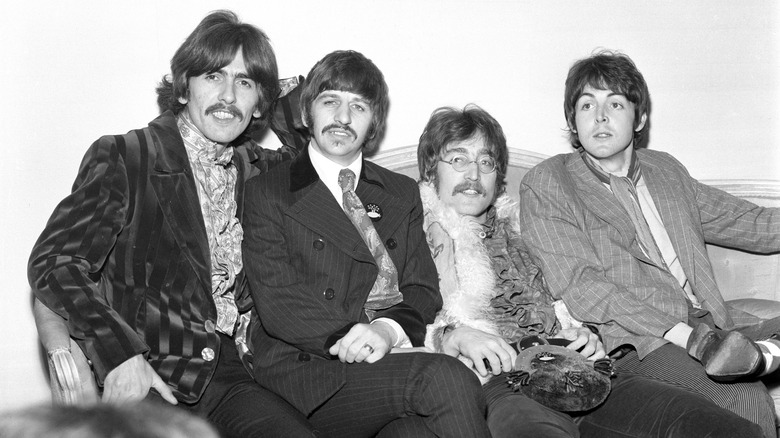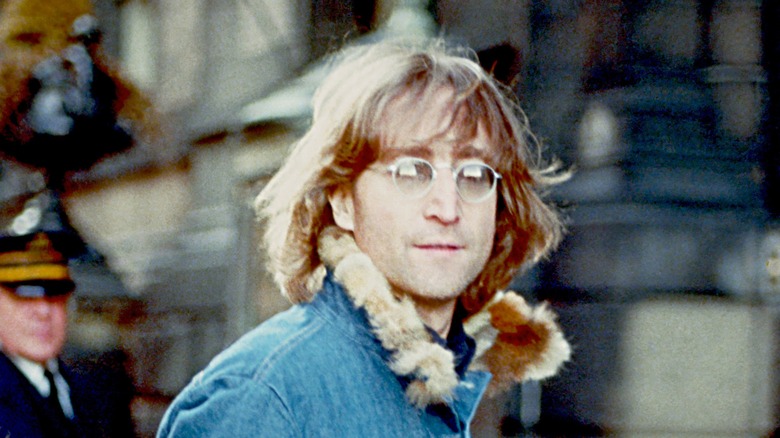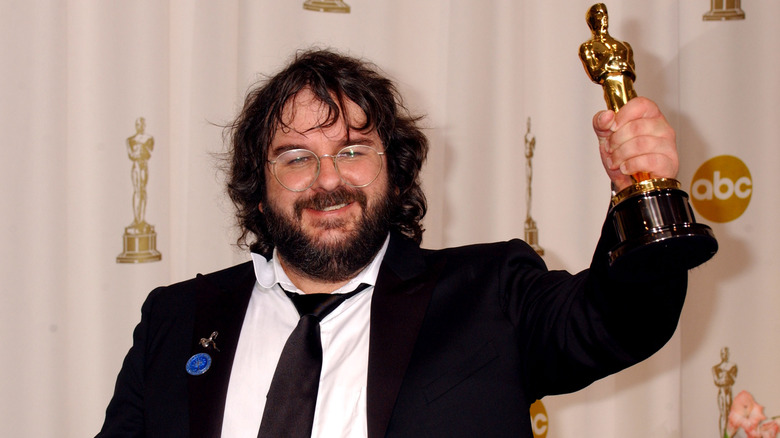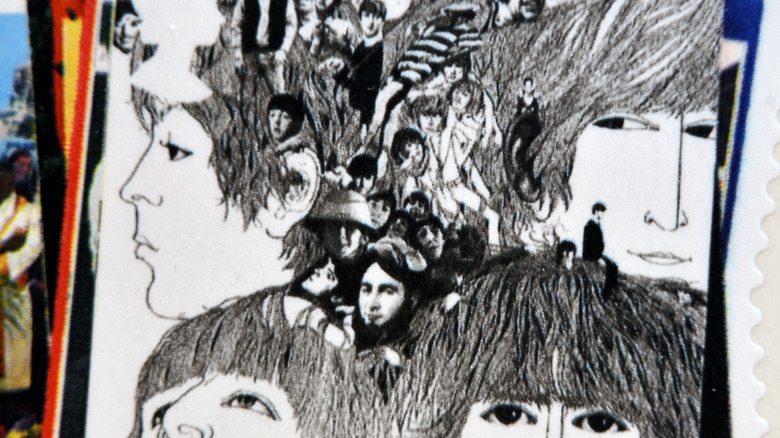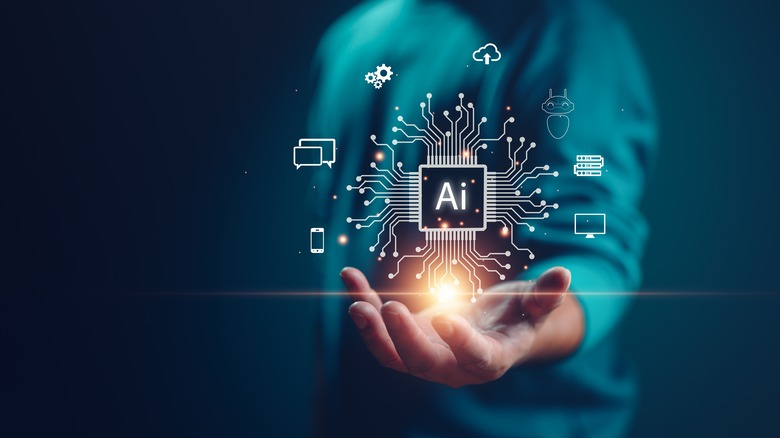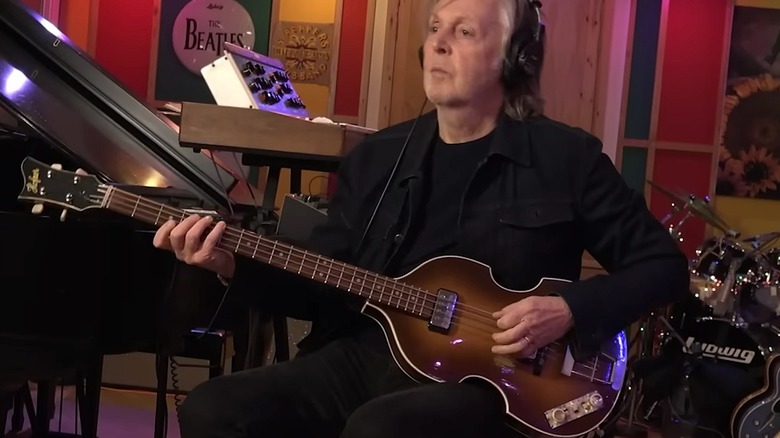How The Beatles Created Their Final New Song In 2023
The last time all four members of the Beatles were in a recording studio together, the tension between the band's two main songwriters — John Lennon and Paul McCartney — was palpable. It was August 20, 1969, during the final mixing of Lennon's song "I Want You (She's So Heavy)" for the "Abbey Road" album, according to "100 Things Beatles Fans Should Know and Do Before They Die." Exactly one month later, Lennon left the band.
More than 50 years since that contentious session, all four members of the Beatles appear on a brand new song — aptly named "Now and Then" — set for release on November 2, 2023, although only two of the Beatles are still alive as of this writing. It involved recordings from 1995 and 2022 sessions and was created with the help of artificial intelligence. "It was the closest we'll ever come to having him back in the room, so it was very emotional for all of us," drummer Ringo Starr said in a press statement (per The New York Times). "It was like John was there, you know. It's far out."
How it started
After Mark David Chapman murdered John Lennon outside of his Manhattan apartment on December 8, 1980, it seemed improbable that the Beatles would ever release new music again. "When we lost John, we knew that it was really over," McCartney recalled in the documentary "Now and Then — The Last Beatles' Song." But then in 1994, Lennon's widow, Yoko Ono, gave the rest of the band a demo he had recorded before his death.
The three remaining Beatles worked with producer and musician Jeff Lynne (of ELO) to record two of the songs on the demo that included Lennon's voice and piano — "Free As a Bird" and "Real Love" — and they were released in the mid-1990s, per Knight-Ridder Newspapers. But at the time, the state of technology was such that they couldn't do anything with the third song on the demo, "Now and Then," because of its poor sound quality, per The Guardian. Thankfully, before the band set the song aside, Harrison, who died in November 2001, recorded electric and acoustic guitar parts for it.
Enter Peter Jackson
In 2017, Peter Jackson — probably best known for directing the "Lord of the Rings" trilogy — began working on a Beatles documentary "Get Back," culling from unused footage from the 1970 film "Let It Be," according to Vulture. The producers believed much of the footage was unusable because the Beatles, especially John Lennon and George Harrison, had purposefully masked their conversations by playing their instruments while they talked. But audio engineers at Jackson's company, WingNut Films, created AI technology that could separate the Beatles' conversations from the music.
"But what-what we've been able to do with computer technology and artificial-intelligence-based technology is we've been able to strip the guitars off now, and expose the private conversations that they had," Jackson told Guitar.com in November 2021. This same demixing technology also allowed him to improve the sound of the Beatles' rehearsals and would later be used to make "Now and Then" a reality.
The technology was used on the Revolver remix
Director Peter Jackson explained to Guitar.com that once the machine-learning technology understood what the various instruments sounded like, be it a guitar, human voice, bass, or drums, it could separate them, even on a mono track. "So the big breakthrough for us was actually not [restoring] the pictures, even though that's what you obviously look at, it was the sound. The way that we managed to split off the mono recordings in the mouldable tracks," he told the site.
This breakthrough technology later helped producer Giles Martin to remix the Beatles' 1966 album "Revolver," per Vulture. Because the original masters included some instruments recorded on a single track, it had previously been impossible to change the sound levels of the individual instruments, but the AI software could do it. "It's like you giving me a cake, and then me going back to you about an hour later with flour, eggs, sugar, and all the ingredients to that cake, that all haven't got any cake mix left on them," Martin told Rolling Stone.
AI makes the new song possible
According to The New York Times, Paul McCartney and Ringo Starr used the same technology created by WingNut films to preserve "the clarity and integrity" of John Lennon's voice in the "Now and Then" demo "by separating it from the piano." "We had John's voice and a piano and [Peter Jackson] could separate them with AI," McCartney told the BBC. "So when we came to make what will be the last Beatles' record, it was a demo that John had [and] we were able to take John's voice and get it pure through this AI. Then we can mix the record, as you would normally do. So it gives you some sort of leeway."
In 2022, once the AI technology split John Lennon's voice from the piano part on the demo, McCartney and Ringo Starr got together to lay down new tracks for the song. "Paul called me up and said he'd like to work on 'Now and Then,'" Starr recalled in "Now and Then — The Last Beatles' Song." "He put the bass on. I put the drums on."
Old and new for Then & Now
The song began when John Lennon recorded himself singing and playing piano on a boombox in his apartment at the Dakota in the late 1970s, per The Guardian. Two decades later, George Harrison laid down guitar tracks at a studio in Sussex, England, per The Toledo Blade. Finally, in 2022, Paul McCartney added piano, bass, and guitar, including a slide guitar part inspired by Harrison, while Ringo Starr rounded out the recording with drums.
"There it was, John's voice, crystal clear," McCartney said in the statement (via The New York Times). "It's quite emotional. And we all play on it, it's a genuine Beatles recording. In 2023, to still be working on Beatles music, and about to release a new song the public haven't heard, I think it's an exciting thing." For McCartney, it was certainly a very different experience from the 1969 final recording session of "I Want You (She's So Heavy)."
